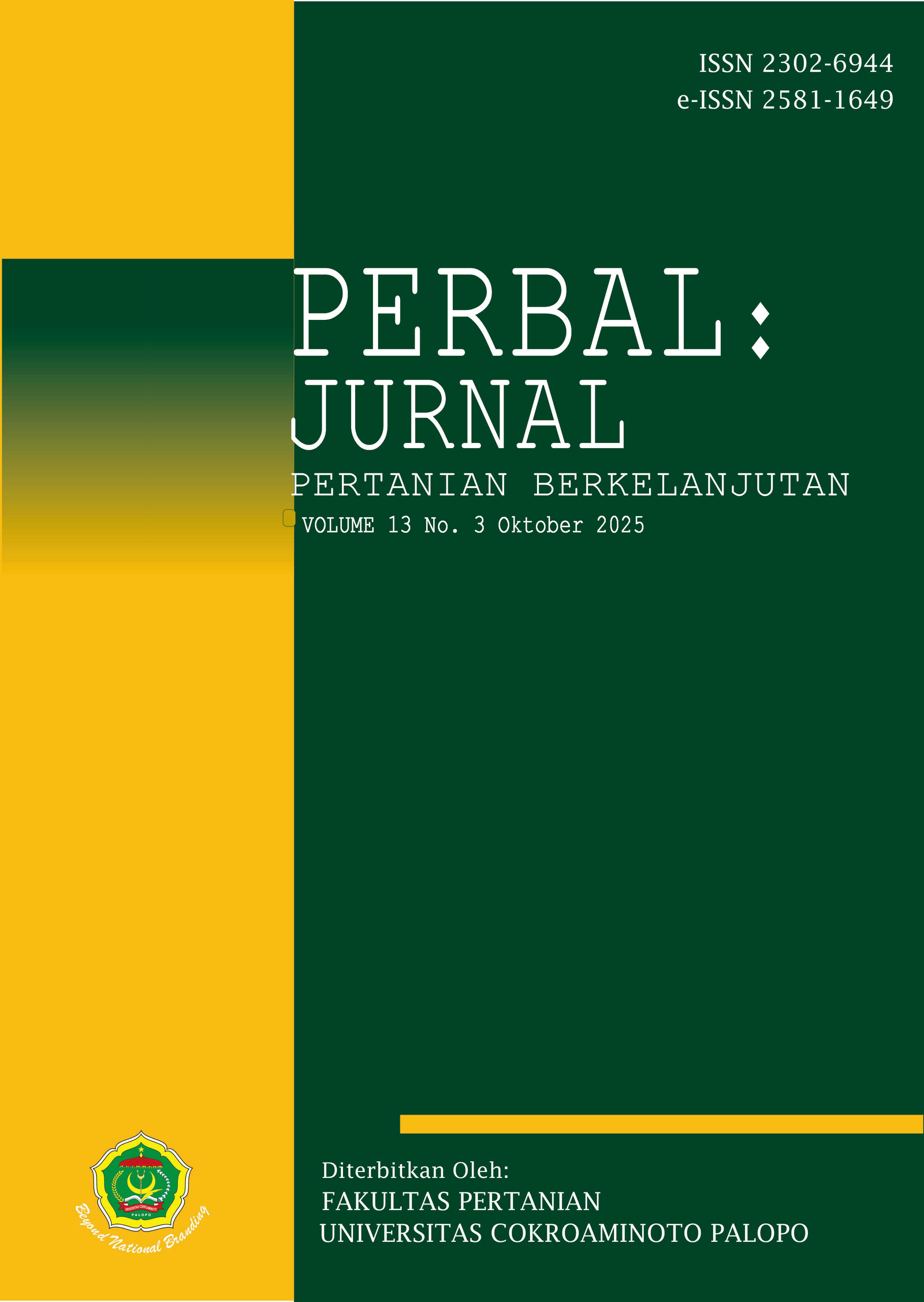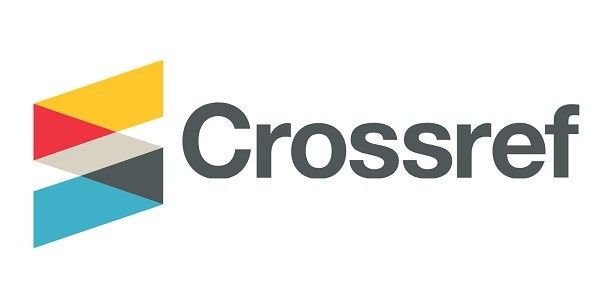Efektivitas Penggunaan Giberelin dan Kombinasi Dosis Pemupukan untuk Meningkatkan Hasil Beberapa Varietas Bawang Merah
Effectiveness of Gibberellin and Combined Fertilization Doses on Shallot Yield Enhancement in Several Varieties
DOI:
https://doi.org/10.30605/perbal.v13i3.7026Keywords:
Bawang merah, giberelin, hortikultura, produktivitas, pupukAbstract
Bawang merah (Allium ascalonicum L.) merupakan komoditas hortikultura yang konsumsi dan permintaannya sangat tinggi di masyarakat. Namun, data menunjukkan bahwa produksi bawang merah dari tahun ke tahun terus mengalami perubahan, yang seringkali memicu fluktuasi harga dan ketergantungan pada impor di beberapa periode. Penelitian ini bertujuan untuk menguji dosis pupuk serta penggunaan giberelin (GA3) pada tiga varietas bawang merah untuk mengoptimalkan produktivitas bawang merah secara berkelanjutan dan efisien. Penelitian dilakukan pada bulan Mei sampai Agustus 2025 di Desa Pancot, Tawangmangu, Karanganyar dengan ketinggian tempat 1200 mdpl. Rancangan penelitian menggunakan Rancangan Petak Terbagi (Split Plot) dan diulang sebanyak 3 (tiga) kali. Petak utama merupakan varietas bawang merah, sedangkan anak petak merupakan dosis pupuk + giberelin. Data dianalisis dengan ANOVA menggunakan uji F pada taraf signifikansi 5%. Jika ditemukan perbedaan yang signifikan, analisis dilanjutkan dengan uji Duncan’s Multiple Range Test. Hasil penelitian menunjukkan bahwa, substitusi 50% pupuk anorganik ke pupuk organik yang dikombinasikan dengan giberelin 50ppm mampu meningkatkan jumlah anakan per rumpun (7,22), jumlah umbi per rumpun (8,33) dan berat kering umbi per rumpun (58,96 g).
Shallots (Allium ascalonicum L.) are a horticultural commodity with consistently high consumption and demand. However, production data reveal frequent fluctuations, often leading to price instability and reliance on imports during certain periods. This research aimed to determine fertilizer dosages and gibberellic acid (GA3) application for three shallot varieties to optimize their productivity sustainably and efficiently. The study was conducted from May to August 2025 at the Pancot Village, Tawangmangu, Karanganyar, located at an elevation of 1200 meters above sea level. A Split-Plot Design was employed with three replications. Shallot varieties constituted the main plots, while combinations of fertilizer dosage and GA3 formed the sub-plots. Quantitative data were analyzed using analysis of variance (ANOVA) at a 5% significance level (F-test). When significant differences were detected, Duncan's Multiple Range Test (DMRT) was used for post-hoc comparisons. The results demonstrated that the application of 50 ppm gibberellic acid, combined with a fertilizer dosage of 50% inorganic + 150% organic, significantly increased the number of shoots per clump (7,21), number of bulbs per clump (8,33), and productivity per clump (58,96).
Downloads
References
Afdila, D., Ezward, C., & Haitami, A. (2021). Plant height character, harvest age, number of children, and harvest weight in 12 local rice genotypes of Singingi quantity. Jurnal Sains Agro, 6(1), 1–9. DOI: https://doi.org/10.36355/jsa.v6i1.496
Arianti, D., Aluh, N., & Jayaputra. (2022). Pengaruh konsentrasi dan lama perendaman biji dengan gibberellic acid (GA3) terhadap pertumbuhan dan hasil bawang merah (Allium asclonicum L.) dari true shallot seeds. Jurnal Ilmiah Mahasiswa Agrokomplek, 1(3), 172–181. https://doi.org/10.29303/jima.v1i3.1455 DOI: https://doi.org/10.29303/jima.v1i3.1455
Arsy, A.F., & Barunawati, N. (2018). Pengaruh aplikasi GA3 terhadap pertumbuhan dan hasil dua varietas tanaman terung (Solanum melongena L.). Jurnal Produksi Tanaman, 6(7), 1250–1257.
Assadiyah, A.N., Dewanti, F.D., & Sulistyono, A. (2023). Respon hasil tanaman tomat (Solanum lycopersicum L.) terhadap macam media tanam dan konsentrasi pupuk organik cair limbah kulit buah. Agro Bali: Agricultural Journal, 6(1), 93–104. https://doi.org/10.37637/ab.v6i1.1079 DOI: https://doi.org/10.37637/ab.v6i1.1079
Astuti, D.P., Kardiyem, Rachmadani, W.S., & Khafidz, A. (2022). Diversifikasi olahan bawang merah menjadi produk bernilai ekonomis tinggi di Desa Genengadal Grobogan. Madaniya, 3(3), 590–598. https://madaniya.pustaka.my.id/journals/contents/article/view/240 DOI: https://doi.org/10.53696/27214834.240
Brigin, A.F., Karuniawan, D., & Wicaksono, P. (2019). Pengaruh GA3 terhadap pertumbuhan dan hasil Snapdragon (Anthirrinum majus L.). Jurnal Produksi Tanaman, 7(6), 1067–1072.
Cokrosudibyo, F.M., Dinarti, D., & Aisyah, S.I. (2023). Pengaruh giberelin (GA3) terhadap pertumbuhan dan komponen hasil bawang merah (Allium cepa var. aggregatum) varietas bima brebes. Bul. Agrohorti, 11(2), 277–285. DOI: https://doi.org/10.29244/agrob.v11i2.46936
Efendi, E., Mahdiannoor, Ninasari, A., & Loppies, Y. (2023). Teknik Pemuliaan Tanaman untuk Pertanian Berkelanjutan. Literasi Nusantara.
Fidiansyah, A., Yahya, S., & Suwarto. (2021). Pengaruh pupuk anorganik dan organik terhadap pertumbuhan, produksi dan kualitas umbi serta ketahanan terhadap hama pada Bawang Merah. J. Agron. Indonesia, 49(1), 53-59. DOI: https://doi.org/10.24831/jai.v49i1.33761
Haryati, W., Novianti, T., & Hidayat, N.K. (2024). Daya saing dan determinan ekspor bawang merah indonesia: Sebuah bukti di kawasan ASEAN. Agro Bali: Agricultural Journal, 7(2), 641–653. https://doi.org/10.37637/ab.v7i2.1732 DOI: https://doi.org/10.37637/ab.v7i2.1732
Hasan, F. (2019). Efisiensi keuntungan usahatani Bawang Merah di Kabupaten Nganjuk: Pendekatan stokastik frontier. Jurnal Social Economic of Agriculture, 8(1), 94–103. DOI: https://doi.org/10.26418/j.sea.v8i1.34137
Kadafi, M., Yarwati, Y., & Sanjaya, R. (2024). Optimasi pertumbuhan dan hasil bawang merah (Allium cepa L. Aggregatum Group) melalui penerapan pupuk organik cair. Tanah Samawa: Journal of Sustainable Agriculture, 1(1), 1–12.
Karomah, N.Y.M., Romdhonah, Y., Ritawati, S., & Rohmawati, I. (2024). Uji pemotongan umbi dan kombinasi media tanam terhadap bawang merah (Allium ascalonicum L.) hidroponik wick system. AgroSainTa: Widyaiswara Mandiri Membangun Bangsa, 8(1), 31–42. https://doi.org/10.51589/ags.v8i01.3745
Kiloes, A.M., Hardiyanto, Sulistyaningrum, A., & Syah, M.J.A. (2018). Strategi pengembangan agribisnis Bawang Merah di Kabupaten Solok. J. Hort, 28(2). DOI: https://doi.org/10.21082/jhort.v28n2.2018.p269-280
Limbongan, Y. (2023). Teknologi Pemuliaan Tanaman. Eureka Media Aksara.
Rachmawati, L., & Koesriharti. (2024). Respon tanaman Bawang Merah (Allium ascalonicum L.) terhadap macam pupuk cair dan dosis pupuk NPK. Jurnal Produksi Tanaman, 12(11), 565–571. https://doi.org/10.21776/ub.protan.2024.012.11.07 DOI: https://doi.org/10.36987/agroplasma.v11i2.6315
Rokhadi, M.Q., & Barunawati, N. (2022). Respon pertumbuhan dan hasil tiga varietas tanaman bawang merah (Allium ascalonicum L.) pada pemberian dosis pupuk ZA. Produksi Tanaman, 010(12), 717–724. https://doi.org/10.21776/ub.protan.2022.010.12.08 DOI: https://doi.org/10.21776/ub.protan.2022.010.12.08
Santoso, A.R., & Maghfoer, M.D. (2022). Pengaruh dosis pupuk P dan konsentrasi giberelin terhadap pertumbuhan dan hasil tanaman Mentimun (Cucumis sativus L.). Produksi Tanaman, 10(1), 19–28. https://doi.org/10.21776/ub.protan.2022.010.01.03 DOI: https://doi.org/10.21776/ub.protan.2022.010.01.03
Sopha, G.A., Widodo, W.W., Poerwanti, R., & Palupi, E.R. (2016). Pengaruh waktu tanam dan giberelin terhadap pembungaan bawang merah dan produksi TSS (True Shallot Seed). Prosiding Seminar Nasional dan Kongres Perhimpunan Agronomi Indonesia 2016, 272–280.
Tarjiyo, & Elfis. (2023). Respon pertumbuhan dan produksi tanaman bawang merah (Allium ascalonicum L.) terhadap pupuk kotoran burung puyuh dan pupuk organik cair (POC) bonggol pisang. Jurnal Agroteknologi Agribisnis dan Akuakultur, 3(2), 115–130. DOI: https://doi.org/10.25299/jaaa.2023.13973
Triadiawarman, D., Aryanto, D., & Krisbiyantoro, J. (2022). Peran unsur hara makro terhadap pertumbuhan dan hasil bawang merah (Allium cepa L.). Jurnal AGRIFOR 21(1), 27-32. DOI: https://doi.org/10.31293/agrifor.v21i1.5795
Triharyanto, E., Nyoto, S., & Yusrifani, I. (2018). Aplication of giberelins on flowering and yield of two varieties of shallot in lowland. IOP Conference Series: Earth and Environmental Science, 142(1). https://doi.org/10.1088/1755-1315/142/1/012066 DOI: https://doi.org/10.1088/1755-1315/142/1/012066
Triharyanto, E., Setyaningrum, D., Hantari, D., & Saputri, R.L. (2025). Budidaya Bawang Merah Melalui Biji. Yayasan Kita Menulis.
Zainudin, A., Ikhwan, A., & Rahmawati, R.A. (2023). Mutant rice plant (Oryza sativa L.) characteristic of M4 generation from MSP13 with higher potential and early age. Journal of Tropical Crop Science and Technology, 5(1), 21–36. https://doi.org/10.22219/jtcst.v5i1.29720 DOI: https://doi.org/10.22219/jtcst.v5i1.29720
Downloads
Published
Issue
Section
License
Copyright (c) 2025 Dimar Hantari, Anditya Gilang Rizky P, Febry Nurhidayati, Desy Setyaningrum, Dewi Nawang Suprihatin, Didik Suryadi, Hardian Ningsih, Edi Paryanto, Cahyaningtyas Putri Suhita, Zainal Abidin, Eddy Triharyanto, Djoko Purnomo

This work is licensed under a Creative Commons Attribution 4.0 International License.
In submitting the manuscript to the journal, the authors certify that:
- They are authorized by their co-authors to enter into these arrangements.
- The work described has not been formally published before, except in the form of an abstract or as part of a published lecture, review, thesis, or overlay journal.
- That it is not under consideration for publication elsewhere,
- That its publication has been approved by all the author(s) and by the responsible authorities – tacitly or explicitly – of the institutes where the work has been carried out.
- They secure the right to reproduce any material that has already been published or copyrighted elsewhere.
- They agree to the following license and copyright agreement.
License and Copyright Agreement
Authors who publish with Onoma Journal: Education, Languages??, and Literature agree to the following terms:
- Authors retain copyright and grant the journal right of first publication with the work simultaneously licensed under Creative Commons Attribution License (CC BY 4.0) that allows others to share the work with an acknowledgment of the work's authorship and initial publication in this journal.
- Authors are able to enter into separate, additional contractual arrangements for the non-exclusive distribution of the journal's published version of the work (e.g., post it to an institutional repository or publish it in a book), with an acknowledgment of its initial publication in this journal.
- Authors are permitted and encouraged to post their work online (e.g., in institutional repositories or on their website) prior to and during the submission process, as it can lead to productive exchanges, as well as earlier and greater citation of published work.














